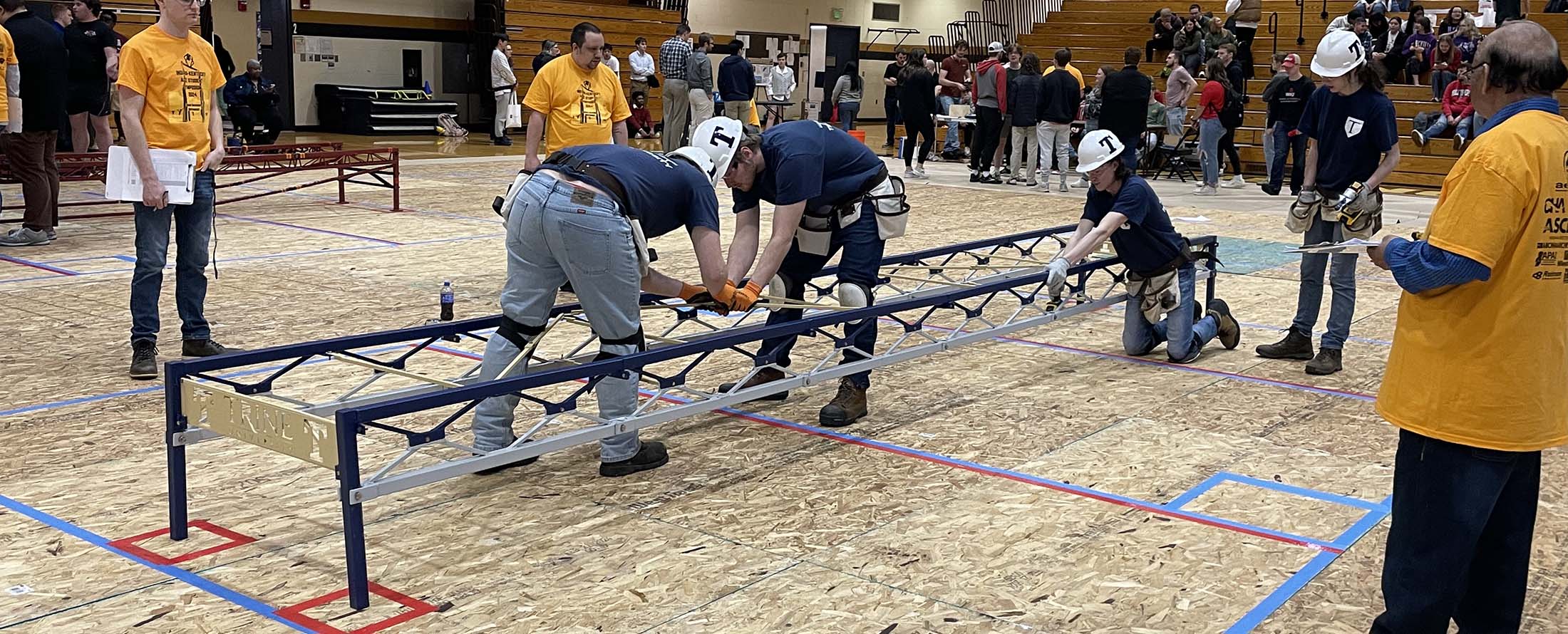
Trine Pre-PA Club introduces profession to Girl Scouts
Members of the Pre-Physician Assistants' Club of Trine University explained to area Girl Scouts what a physician assistant does at a special event on Oct. 19.
April 30, 2024

HAMMOND, Ind. — The Trine University student chapter of the American Society of Civil Engineers (ASCE) built a bridge to national competition.
For the first time, a Trine team took the top place in the regional steel bridge competition, qualifying for ASCE national student championships.
Trine also won the concrete disc and mystery design competitions, finishing third overall at the event.
The ASCE Indiana-Kentucky Student Conference was held April 11-13 at Purdue University Northwest in Hammond, Indiana. Civil engineering students from 12 universities in Indiana and Kentucky took part in the event.
Strength and style
Trine civil engineering majors Thaiphi Austria of Saipan, Kyle Baumgartner of Warsaw, Indiana, and Chris Parker of Lebanon, Indiana, completed Trine’s steel bridge for their senior design project.
They were assisted in building at the competition by Annalise O’Daniel, a civil engineering major from Indianapolis, and Joey Schmidt, a mechanical engineering major from Muncie, Indiana.
In addition to first place overall, the team took first for construction speed, aesthetics and structural efficiency, second for cost estimation, stiffness and construction economy, and third for lightness.
The annual AISC ASCE Student Steel Bridge Competition challenges students to design, fabricate and construct a steel bridge that meets specific criteria, including size, weight and construction materials.
“We started our design process by analyzing previous schools’ bridge designs for the competition. We looked at what they did well, what went wrong and what got them disqualified,” said Parker.
Parker said the team developed their big picture for the bridge, then designed and tested individual connections using RISA 3D and Ansys Static Structural software.
“These tools let us determine if the bridge connections were strong enough to handle a 2,500-pound load,” he said.
The Trine team’s bridge stood out by using multiple colors and custom parts, including a university logo.
“Many competitors had someone else fabricate their bridge, but they completed design work,” Parker said. “However, our team took the extra step to design and manufacture the entire bridge using Industrial Construction and Engineering’s facility.”
During the competition, teams assemble their bridges on-site within a specified time limit. The bridges then undergo a series of tests to evaluate structural integrity and performance, including load testing.
“It was a huge relief to win the competition, finally,” said Parker. “Our team poured hundreds of hours into designing and fabricating the bridge. We had so much support during the competition. It made the victory so exciting to see all our hard work pay off.“
The national competition will take place May 31-June 1 at Louisiana Tech University.
Heavy discs
For the concrete disc competition, students were tasked with designing and constructing discs similar to those used for disc golf, but made out of concrete. Teams were judged based on durability, aesthetics, weight and putting accuracy.
The Trine team included civil engineering majors Ryan Hoak of Warsaw, Indiana, Dillon Cooper of Seymour, Indiana, Derek Maag of Ottawa, Ohio, and Gage Ornduff of Elkhart, Indiana.
Hoak, who served as captain, said he was drawn to the competition by his passion for disc golf.
“Our first task was to experiment with various mix designs to create ultra-high-performance concrete (UHPC) capable of withstanding ground impacts,” he said. “While we initially encountered difficulties finding suitable mix designs, we persevered through testing approximately five or six variations until finding one that met the competition's requirements and still held together after curing.”
The team then encased a normal golf disc in silicone to create a mold. After removing the concrete discs from the mold, they sanded and ground them to create a smooth surface, then painted the discs to enhance the appearance.
“Our precise mold and meticulous sanding improved both the aerodynamics and aesthetics of the disc,” said Hoak. “The inclusion of steel fibers in our mix allowed us to create thinner discs without sacrificing strength, significantly reducing their weight. The vibrant paint job added a visually striking element.”
“Winning the competition brought immense satisfaction after countless hours and late nights spent working on the project throughout the semester. Overall, it was a rewarding experience to see our hard work pay off in such a tangible way.”
Extra weight
Hoak also served as captain of the mystery design team, which included Cooper as well as Blake Dulle of Edon, Ohio.
In the mystery design competition, students work as a team to accomplish a given task, which is not revealed until the time of the event.
This year, students were tasked with building a tower from glue, cardboard and popsicle sticks. The towers were judged on height and strength.
Trine won the competition for the second year in a row.
“We decided to focus more on creating a uniform structure with as much reinforcement and bracing as needed to make the structure as sturdy as possible,” said Dulle. “I believe we were the only group to fortify our base by putting dowel rods and popsicle sticks on diagonals to increase support.”
“While we weren't given specific rankings during the event, we witnessed our structure, which was among the tallest, successfully support an impressive weight of 485 pounds,” Hoak said.
“Trine’s tower stayed standing after all of the original test weights were applied,” said TJ Murphy, faculty advisor. “The event organizers had to travel over to the steel bridge testing area and use their test weights.”
Gary Greene, Ph.D., chair of the Reiners Department of Civil and Environmental Engineering, said Trine’s success in ASCE competition stems from the many opportunities students have to develop laboratory skills, work in groups experiment with new equipment and ideas.
“Trine typically performs very well against much larger civil engineering programs,” he said. “This year we exceeded our performance from the last several years.”